|
As
we started to descend toward the coast, we frequently saw sheep
lying by the side of the tarmac, or cows nonchalantly strolling
down the lane. No
fences – they are free to graze wherever they like, and drivers
are expected to avoid running them down.
This is fairly common in rural areas of Ireland, even on
some heavily traveled roads.
And
the ponies! The
Connemara region is famous for its ponies, and soon we were seeing
them everywhere, roaming free on the open moors.
A group of ponies here, a mare and foal there - out on
their own with no fences in sight.
Most of them were grey, with the occasional bay or buckskin
thrown in. They must
belong to someone, but were turned out on the lonely moors to
forage for themselves. We
stopped at an old stone shepherd’s cottage with thirteen ponies
clustered nearby. They
were quite friendly, and allowed us to approach them.
I noticed a plastic
bag littering the road. I
bent to pick it up, doing my part to keep the countryside clean,
but also with the ulterior motive of obtaining another bag with
which to organize our errant groceries.
But I quickly abandoned my attempts to beautify Ireland
when I realized it was full of fish guts and stank to high heaven.
As we came to lower elevations we
started seeing farms and houses again.
We reached the coast at the tiny town of Rossaveel, from
where the ferry to the Aran
Islands launches. It
is a quiet, old-fashioned village, and the people there still
speak Irish Gaelic.
We started trying to find a room;
normally booking lodging on the fly is not a problem in Ireland,
but it was a Bank Holiday weekend, and every place we went was
already full. Finally
we found a room over the local pub, where we had a very sub par
dinner while watching rugby on TV in the bar.
(I had never seen rugby played before, and I was quite
impressed; it is a fast paced cross between football with
no pads, basketball, soccer, and keep-away.)
There
was still a little while of fading daylight left, so we went in
search of a good Happy Hour spot.
We drove down all the small coastal roads nearby, but
couldn't find a good secluded parking space with a view.
It was getting dark quickly, so finally we settled for
parking right by the road, overlooking the water.
We opened a bottle of the Chablis we had gotten on sale,
but to our dismay it was undrinkably bad, and we poured it out.
We realized that we had given Clare a bottle of the same
wine as a thank you gift; we vowed to apologize.
On the whole, not our finest happy hour.
We returned to our room above the pub, where we found the
beds to be as hard as a brick.
Sunday August 5
We set out full of anticipation - we had
the whole of the Connemara peninsula before us.
We were eager to see where the road ahead would lead us.
With Clifden as our destination, we looked at our map and
chose the smallest roads we could find to get there.
We headed west along the coast.
On an inlet to our left, hundreds of white swans floated on
the water. The road
was lined with hedges of flowers in a myriad of colors: red
fuchsia, purple thistle blooms and butterfly bushes, white
daisies, and several types of yellow and orange flowers we could
not identify. We saw a
few scattered windblown trees standing along the shores of a lake,
and white gulls wheeled overhead.
Turning inland, we
passed houses and small farms, the fields and paddocks fenced with
stone walls. There
were ponies and sheep everywhere we looked.
We headed up into the hills, crossing the highlands on a
narrow less-traveled road – the only traffic we encountered was
some bicyclers. The
fuchsia hedges were replaced by pink heather growing among craggy
rock outcroppings. There
are shallow lakes hidden in every fold of this treeless
countryside, the water dark from the peat bogs.
It is a rugged and desolate land, with its own unique
beauty.
We passed a number of bogs where
peat was being harvested; the oily soil is cut into bricks, which
are dried and then used for fuel in lieu of firewood.
Larger operations have huge machines that slice the peat
soil into chunks, but some of the older farmers still cut it by
hand. Large stacks of
cut peat bricks were drying by the side of the roadway.
Travelling
the length of the Connemara peninsula, we arrived at Clifden
midday. Our first
order of business was to find lodging,
which did not prove to be easy - the Connemara Pony Show
was taking place that week so accommodations were all booked up.
Luckily we found a B&B that had just gotten a
cancellation for the next two nights, so were able to reserve a
room at a nice B&B called Lough Faada, in Ballyconnely near
Clifden.
We
went to the Connemara National Park.
Irish dancers were performing to traditional music at the
visitor’s center, and it was all a bit on the touristy side for
our taste. We hiked up
Diamond Hill, a small mountain within the park.
There were more people on the trail than we would have
liked, but the scenery was beautiful, and it was a perfect warm-up
hike for the start of the trip.
|
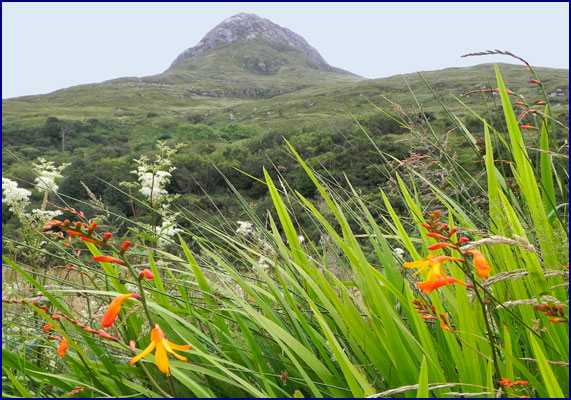
Diamond Hill
|
By the time we
returned to the car it was late afternoon, but the daylight lasts
quite late in Ireland in the summer, and we didn’t want to waste
a moment of it. We
drove out to the Renvyle Peninsula, on the very northern part of
the Connemara coast, where few tourists venture.
This was one of the most beautiful areas we saw in
Connemara, all rolling hills and green farmland, but rocky and
rugged with a slightly wild feel to it.
I would like to live there.
We
had a large-scale map which showed all of the tiny byways, and as
usual we took the smallest road we could find, following a bumpy
lane along the edge of a cliff.
A fuchsia hedge lined one side of the road and the bay was
far below us on the other. Swallows
dipped and swooped alongside us, catching the insects the car
scared up. We turned
around where the road comes to a dead-end, on a high ridge
overlooking the water.
Our
map showed a castle out near the tip of the Renvyle Peninsula, so
we went in search of it. We
drove along the north Atlantic coast.
Hedges of flowers lined the way, and paddocks made of stone
walls stretched up the hillside.
One of the best things about
Ireland is the castles. When
one is marked on the map, you never know whether it will turn out
to be a grand fortress open to the public, or the ruin of a tiny
castle in a farmer’s field, being used as a run-in shed for the
cows. The Renvyle
Castle proved to be the latter, but instead of cows it sheltered
Connemara ponies. The
remains of a tower house similar to the one where we found the
chalice, it stands in a paddock, on a knoll overlooking the water.
Only about half of the castle still remains, the rest
having crumbled with the centuries.
It is on private property and marked with No
Trespassing signs, but the owner gave us permission to enter.
A pretty grey pony mare grazed nearby, with a cheeky bay
foal that pestered us to scratch his rump and tried to follow us
into the castle.
|
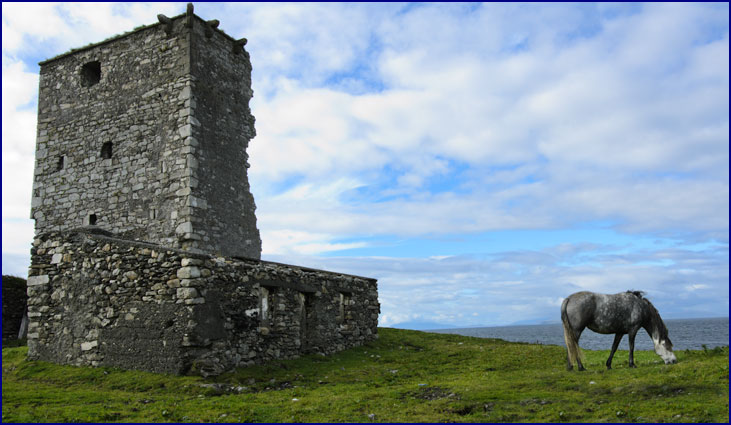
Renvyle Castle
|
We
returned to Clifden and took the upper Sky Road - Jineen and I had
driven this aptly named road before.
On our previous trip to Connemara, driving Sky Road along
the ridge above the bay, we had glimpsed a fabulous castle in our
rearview mirror and quickly turned around to visit it.
That is how we discovered Clifden Castle; it became one of
our favorite places in Ireland, and we had long looked forward to
returning. This time
we parked in a gateway, half in the road really, and walked down
through the field to a good vantage point.
Clifden Castle is situated on a hillside, surrounded by
green pastures that stretch down to the bay.
Sheep were grazing nearby.
The sun broke through the gathering clouds, bathing the
castle in a golden light. It
was like a scene straight out of a fairy tale.
|
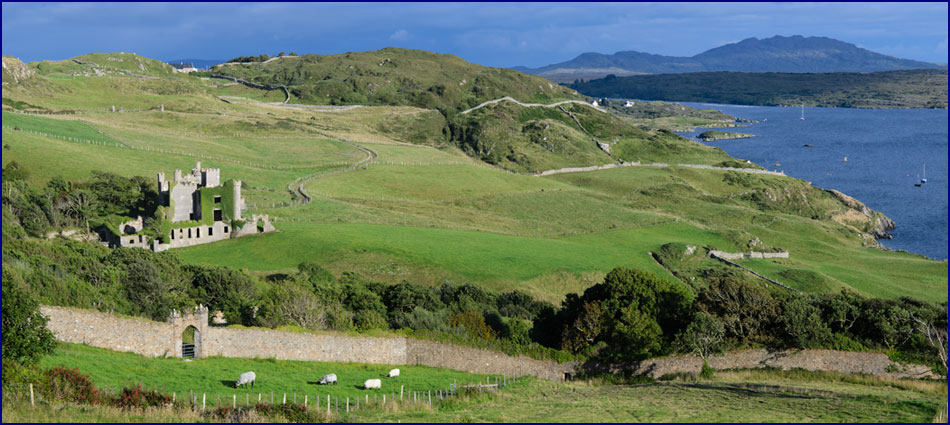
Clifden Castle
|
Near the gateway
where we parked, two men were laying the foundations of a
building, on a site looking down over the castle and the bay.
We asked them if they were going to live there; they told
us no, it was to be a shed for the cows.
Wow, this great spot with the fabulous castle view, and
they were building a cowshed!
I couldn’t decide if this was a darned shame, or the most
wonderful thing in the world.
The light was fading fast, so
rather than walk down to the castle we planned to come back
another day. We
continued up Sky Road and parked at the top of the ridge to watch
the sunset. Great
shafts of light broke through the clouds as the sun dropped toward
the horizon. The sky
turned a fiery orange against dove grey ocean.
We had cheese, chutney, and pate on crackers, with a good
Sicilian wine. It
doesn’t get much better than this.
|
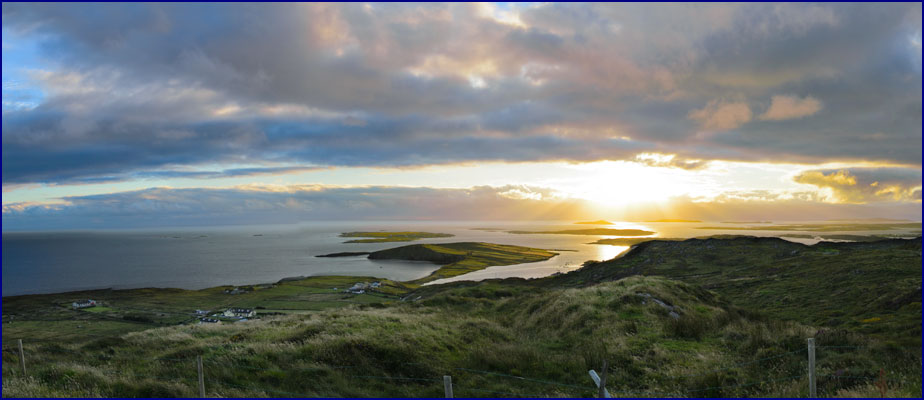
Sunset on Sky Road
|
Monday
August 6
In the morning we headed east to the Maumturk Mountains
under overcast skies. We
had planned to go hiking, but when we came to the trailhead it was
raining intermittently, and a heavy mist was rolling in over the
mountains. We decided
to drive around the Inagh Valley in hopes that the weather would
improve. We followed the narrow lane as it wound past lakes and
through bogs. A few
farmhouses stood beneath the shadow of the brooding mountains, and
sheep grazed on the open moor.
We
came upon a large donkey standing beside the road - I stopped the
car for a better look, and to our surprise the donkey immediately
marched up to the vehicle and stuck his head in through Jineen’s
window, expecting a handout no doubt.
He was very polite, and stood for a long time with his head
in the car while we fondled his enormous ears and fed him ginger
nuts and polo mints. He
obviously considered this treatment his due.
Taking
leave of our new friend, we completed the circuit around the
valley and back to the trailhead.
The weather had gotten worse, with steady drizzle and great
banks of fog rolling in, so we decided to save the hike up the
mountain for another day. Heading
back toward Clifden, we stopped by Kylemore Abbey, a grand
Benedictine monastery that sits beside a lough (Irish for lake).
We took photos of this beautiful building from across the
water, but because it was crowded with tourists we did not go
inside. (Even though we were technically tourists ourselves, we
always try to avoid such crowded touristy attractions.)
|
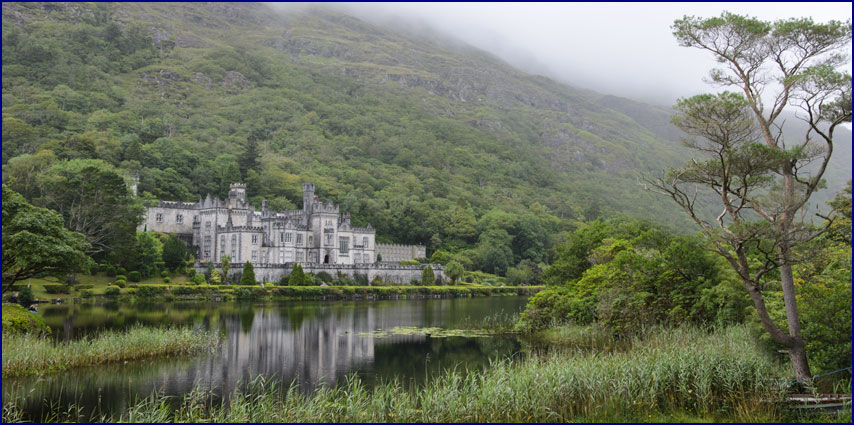
Kylemore Abbey
|
Around midday we checked in to the Winnowing Hill B&B.
This excellent guesthouse sits on a hill at the top of a
steep drive, with a lovely view of Clifden.
We were served tea and scones, and made to feel very much
at home. By two
o'clock the rain was lighter, and we decided to go back to the
Clifden castle.
Parking
at an intersection on Sky Road, Jineen and I put on our raincoats
and set out down a narrow gravel lane, walking in a light misting
rain. We went by the
small gatehouse near the entrance, where the road passes under an
archway between pillars of stone.
Beside it, attached by retaining walls, sits a stone
cottage. Vaguely
wondering if we were trespassing, we followed the winding lane
down the hill. A
fuchsia hedge was in full bloom, its deep red blossoms heavy with
rain droplets. Stone
walls and dense hedges line the road, giving way to barbed-wire
fences closer to the castle. Stone
obelisks stand sentinel like guardians of the ages.
This road brought back memories of the first time we
traveled it.
When
we had first glimpsed Clifden Castle in our rearview mirror from
Sky Road back in December of 2001, we searched for a way to get to
it, and ended up driving our rental car down this lane.
It had been almost sunset, and very wet. When we had
finally reached the castle, we found the road flooded by a huge
puddle. There was no
way to drive around it and no place to turn around, and it was too
deep to drive through. After
briefly exploring the castle, we had no choice but to reverse the
rental car all the way up the narrow lane.
It was almost a mile of backing up the hill in the fading
light, around turns and between stone walls and fences, with me
driving and Jineen hanging out the passenger side window
directing, and the rental car’s clutch smoking.
It became one of our most memorable experiences.
We were happy to be walking this time, with no fears of
burning out the clutch. We
passed the standing stones and rounded the final turn to where the
castle came into view. A
soft rain was falling, and mist rolled in off the bay.
Large and imposing, standing on a green hillside above the
bay, Clifden Castle looked like something out a dream.
|
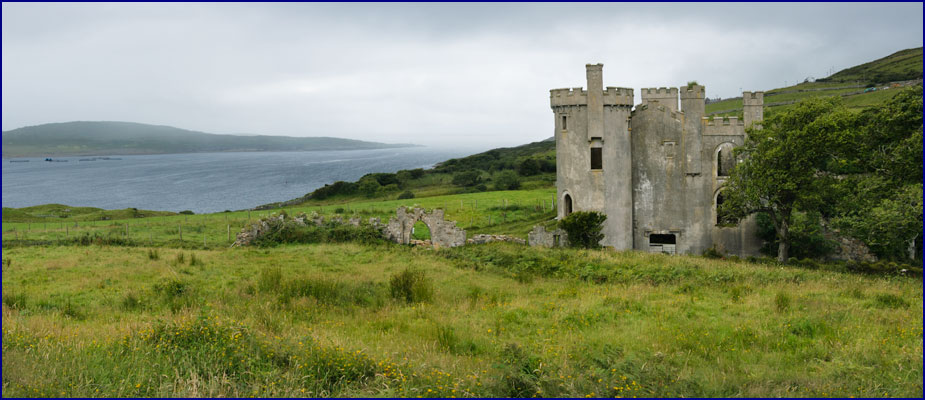
Clifden Castle
|
We followed the lane between fenced pastures, down to the
front of the castle. Near
the stone arch at the entrance was a farm gate with a sign on it
that warned, “Beware of Bull.”
(An apt commentary on life in any era, I suppose.)
We climbed over the fence to avoid the puddle that still
claimed the end of the road, and entered the castle grounds
through a field of ferns.
Clifden Castle is
fairly new, as castles go, less than 250 years old.
The great rectangular main structure is flanked by round
towers and crowned with indented parapets.
Unlike the more ancient towerhouse castles, it has many
large arched windows and doorways.
The walls of stone, four feet thick, are coated with a
layer of cement (where it hasn’t been chipped off over time),
giving the castle a smooth grey appearance.
Its roof is long gone, but the internal walls are still
mostly there. Decorative
arches frame many of the doors and windows. Stone and plaster
carvings adorn the outer walls; the faces of kings look out on the
ages, and stone lion’s heads grace the battlements.
On the back side of the castle, the wall is mostly covered
in ivy.
We spent a lovely afternoon exploring the castle and the
grounds. We wandered
from room to room, following the narrow corridor that runs the
length of the castle, passing through numerous arched doorways.
We collected souvenirs of rock from the crumbling walls.
Having brought some supplies with us, we sat in a deep
recessed window to avoid the rain and had Happy Hour, with wine
and trail mix.
Behind
the castle, a path leads down over a small stone bridge to the
remains of what must have been the stables and servants quarters.
It is a rectangular court surrounded with stone structures,
partitioned into stalls and rooms.
There is one section that has been restored, with several
stalls that have wooden doors and a tin roof - it must have housed
horses in the not too distant past – but the rest of the stables
have fallen into ruin. Ivy
so old that it has formed thick woody trunks like trees climbs the
walls, and many of the chambers are choked with tall weeds.
We walked down the hill and stood
by the edge of the bay. The
rain was letting up, and as we turned back up the hill a bit of
sunlight broke through, bathing the castle in a warm glow.
We said goodbye to Clifden Castle, and headed back up the
winding lane, happy to be walking forward rather than driving in
reverse.
|
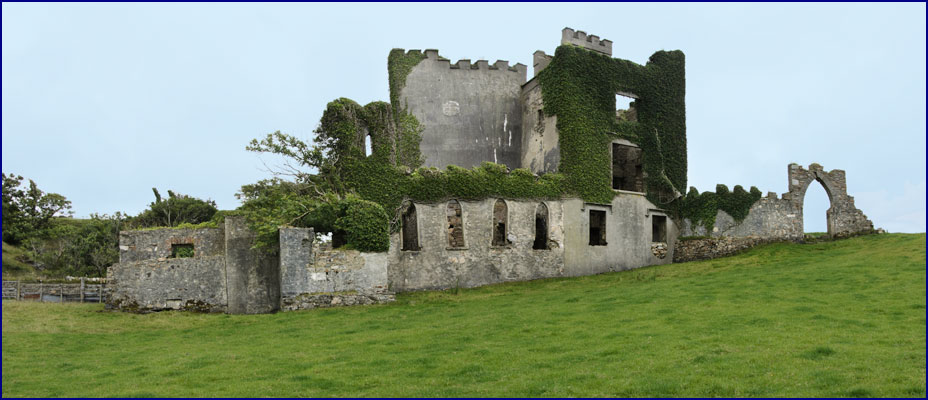
Clifden Castle
|
Walking
around Clifden town, we looked in the shop windows.
We passed two cars that seemed to be permanent homes for
small dogs, a rather large cat, and several chickens.
We went to J Coneeley’s Pub for dinner and live Irish
music, the perfect end to an awesome day.
|